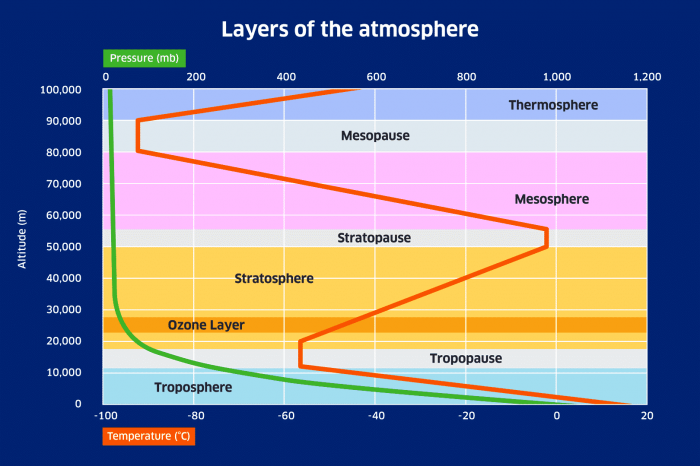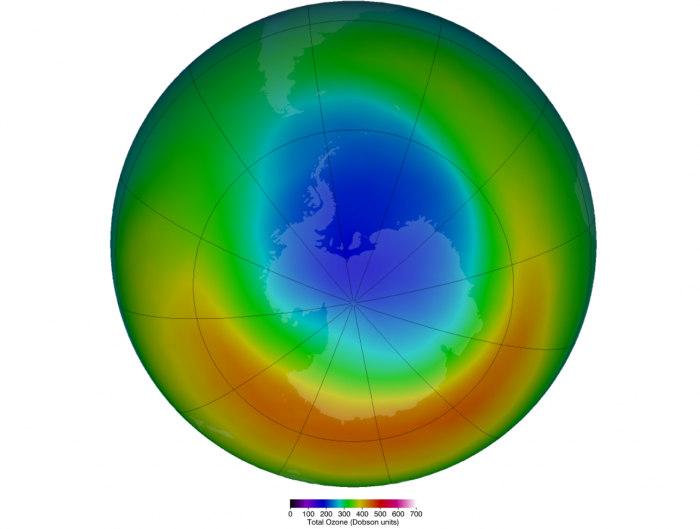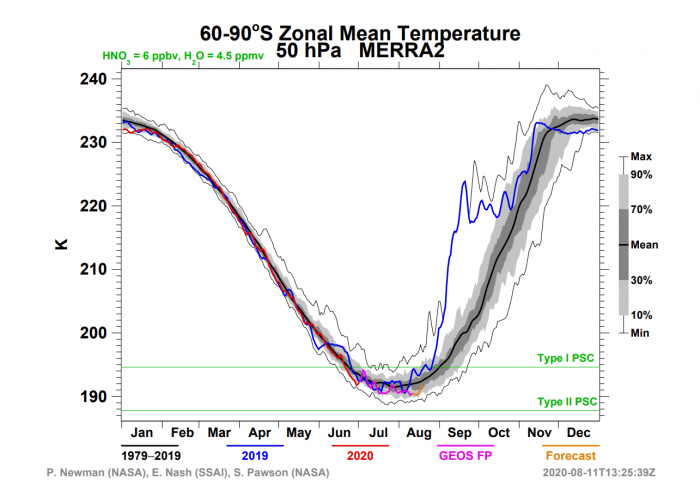Sunlight has reached the stratosphere over the South Pole. Combined with the polar stratospheric clouds, the ozone destruction process has now begun, creating an ozone hole over Antarctica.
Ozone is the protective layer in the atmosphere, that shields us from dangerous solar UV radiation. In the late 20th century, human emissions of chemical substances called halocarbons adversely affected the number of ozone molecules in the atmosphere. It resulted in the creation of a dramatic annual ozone hole over the Antarctic region.
Most of the protective ozone layer is in the lower stratosphere, at an altitude of around 25km (82.000 ft). The image shows the layers of the atmosphere and the altitude of the protective ozone layer. The highest concentration of ozone can be found a few kilometers lower over the polar regions.
On the NASA ozone analysis below for September 2019, we can see high values of ozone in orange, powered by the stratospheric warming over Antarctica. The ozone hole (lower values) was a bit limited in size and did not feature severely low values of ozone (violet color).
We produced a high-resolution video, which shows the current (August 2020) ozone hole over the South Pole and its circulation over Antarctica.
OZONE DESTRUCTION PROCESS
If we want to destroy ozone and create and grow the ozone hole, we need two main ingredients: cold temperatures and sunlight. Cold temperature enables the stratospheric clouds to form. As long as it remains dark, nothing happens with these clouds. But when south polar spring arrives (Aug-Sept), UV radiation from the Sun reaches the Antarctic Circle and reacts with the clouds. It starts a photochemical process of chlorine release and ozone destruction.
The theoretical threshold for stratospheric clouds to form is below -78°C (-108.4°F). The images below show the average temperature over the wide Antarctic circle at 50mb level (~19km altitude). The current temperature is below the threshold for polar stratospheric clouds (PSC) to form. That means it is cold enough to start the ozone destruction process once UV radiation is involved.
Minimum temperatures south of 50°S latitude are within normal values, and below the minimum threshold for PSC level 2 to form.
The GFS model forecast for the 50mb level (~19km altitude), shows the minimum temperatures over the Antarctic to drop below -90°C. Violet and black colors show the temperatures below -78°C. It reveals quite a large area of temperatures that support stratospheric cloud formation and ozone destruction.
The analysis from NASA shows the volume of the polar stratospheric clouds formed by ice and nitric acid trihydrate (NAT). Both types of clouds are in abundance, with above-normal volume. This shows that the stage is set for the rapid growth of the ozone hole in the coming weeks.
THE OZONE HOLE
Actual total ozone values over the Southern hemisphere already reveal the minimum area over western Antarctica, so it is directly in line with the area of lowest temperatures shown above.
Sunlight is already starting to reach the south polar stratosphere. Because of that, the ozone destruction process has begun and the ozone hole is starting to grow. The image below shows the current area size of the ozone hole. It is within the normal values for this time of the year but can increase quickly. The ozone hole is usually largest in September/October. That is because of the most potent combination of high UV radiation and low temperatures. Towards the end of the year, the stratosphere slowly warms. It is not cold enough anymore to destroy ozone, despite the abundant UV radiation.
The ozone values over the south polar region are slightly below average and are reducing because of the seasonal ozone destruction process.
A stratospheric warming event can quickly raise the temperatures in the stratosphere and stop the growth of the ozone hole. That is exactly what we have seen last year. The current data shows above-average temperatures around the polar vortex over Antarctica, but it is not (yet) a proper warming event.










